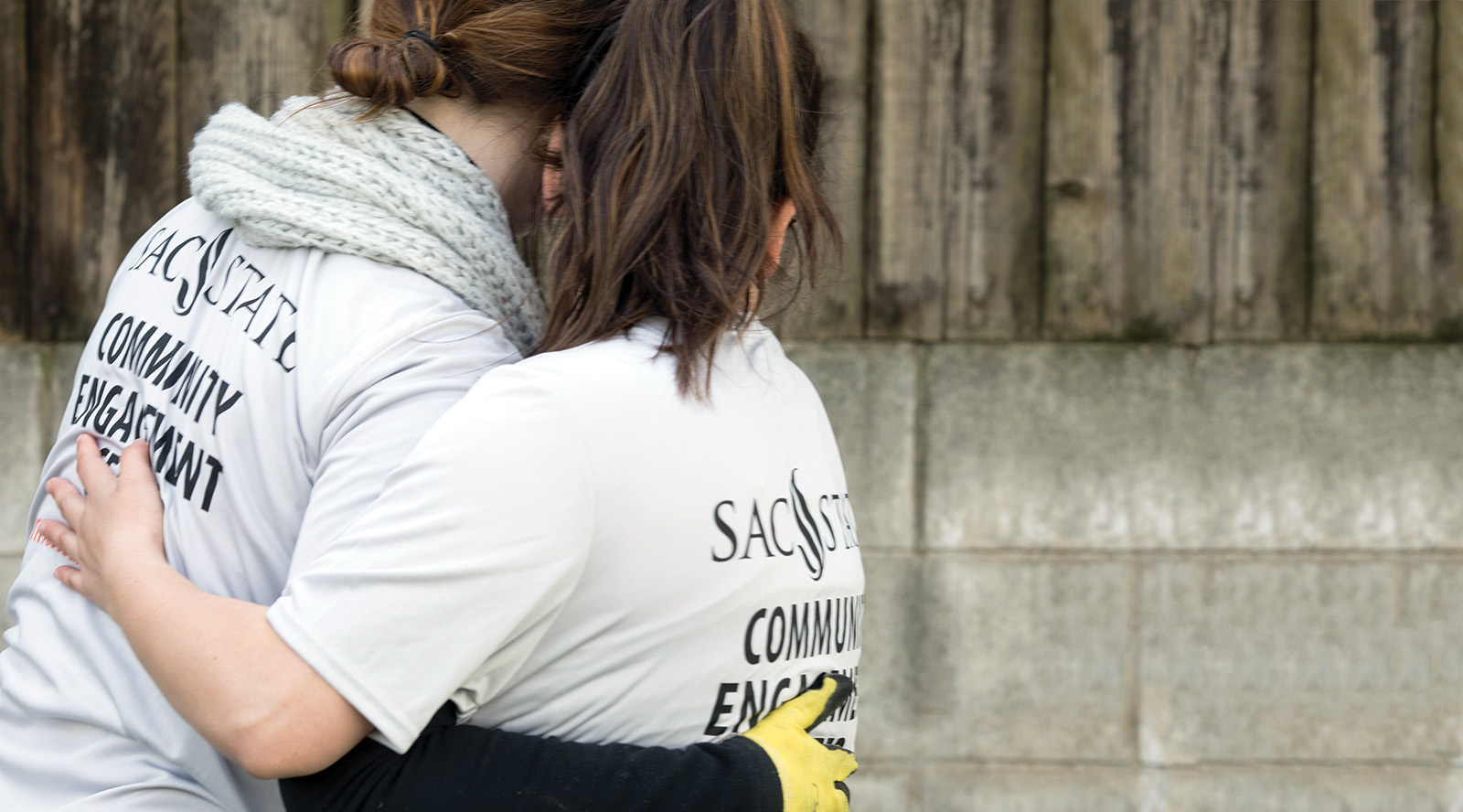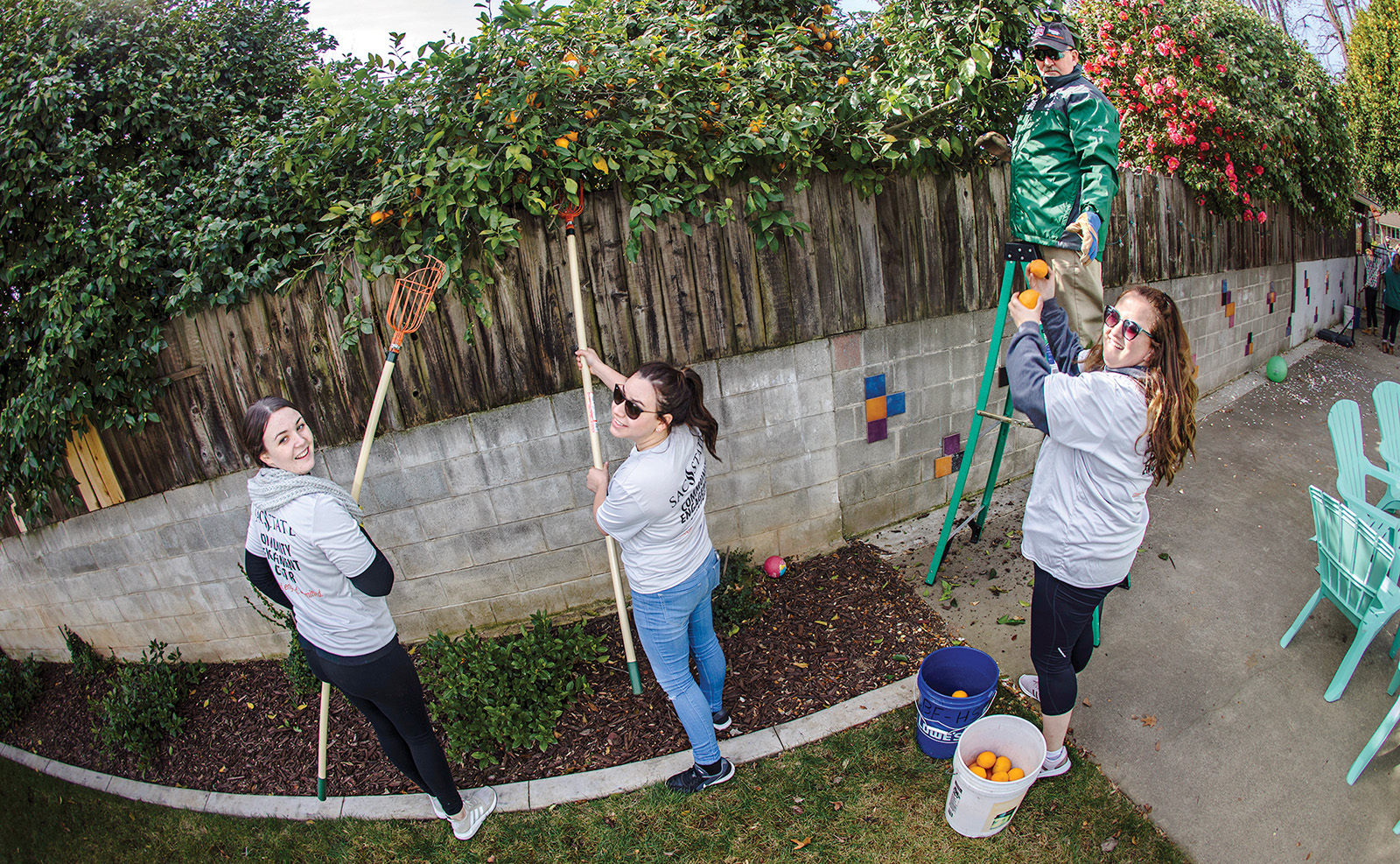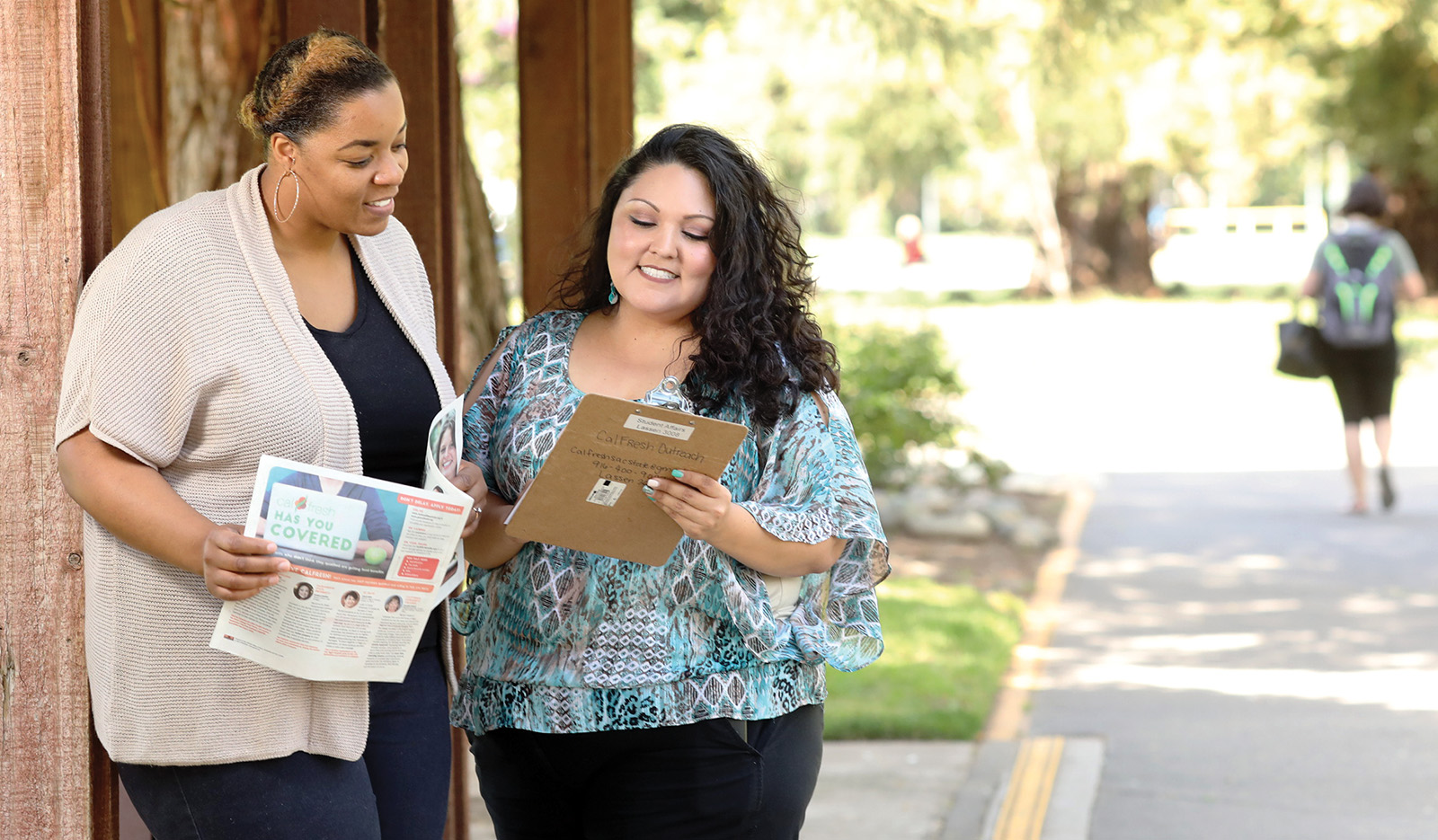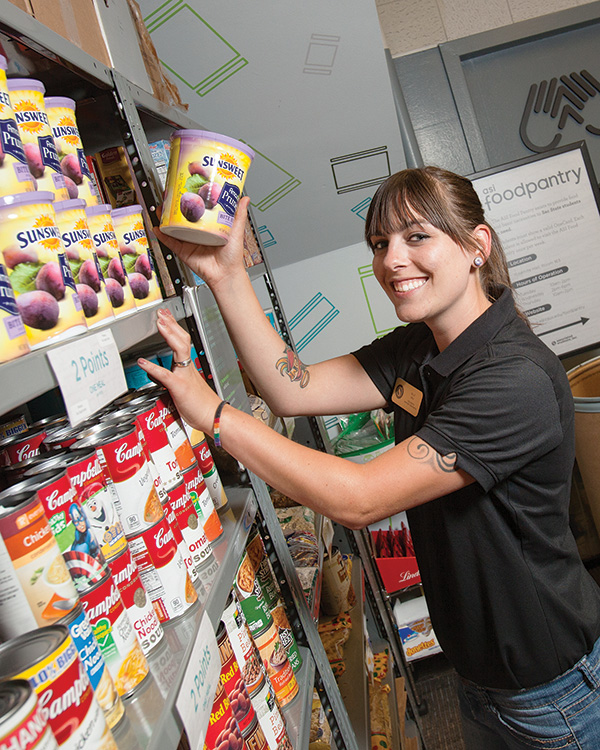

When hard times loom
Sac State shows how much it cares
Dixie Reid
The first time Regina Montoya experienced a stable home life was upon entering foster care at age 13. Before then and for years after, she bounced around, living with various relatives or staying with friends.
VIDEO: Sacramento State President Robert S. Nelsen says students facing hunger and homelessness need the kind of help being provided through several programs on campus. He urges even more action to continue building a culture of caring at the University.
We work to create a secure place where students thrive
In addition to transforming the lives of our students, Sacramento State is dedicated to creating a culture of belonging, safety, and inclusion.
It is difficult, however, to create a culture of success when so many of our students face homelessness, displacement, and food insecurity. The inability to meet basic needs restricts students’ academic achievement and takes a toll on their mental and physical health. Unfortunately, too many of our young people at Sacramento State are struggling to make ends meet. Expecting students to succeed academically while experiencing food insecurity and homelessness is not only counterintuitive; it is asking for a miracle.
In summer 2015, Associated Students, Inc., opened a food pantry on campus after a study found that 60 percent of our students needed help supplementing their basic diet. The pantry has been such a great success that we are moving its operations to a larger location and have had to secure additional space for food storage at multiple sites around campus in response to generous donations.
To better serve students in crisis, we have hired a case manager and a team of interns who interact directly with students to help them find solutions and resources to meet their needs and keep them in school. Our case manager often manages more than 150 cases per month and has worked with over 50 students who have been evicted because they cannot keep up with the skyrocketing rent in the area.
We have four beds in residence halls available for emergency housing, and they are consistently full. As we work to increase our capacity, we also seek other solutions. We are installing lockers and finding bikes for our students who live in tents or are homeless so that they can come to campus, attend classes and study while having a secure space to store their school supplies and belongings. We have also established for our students in crisis the Student Emergency Fund, which provides grants to students who are experiencing unanticipated expenses or a financial emergency.
I am proud of our efforts at Sacramento State, but there is still significant work to be done to meet the basic needs of all of our students. We cannot solve this problem alone, and we are grateful to everyone in the region and the CSU for their support of this important initiative. The accompanying story contains more about our students’ struggles with basic needs and the resources available to them. I am proud of the work we are doing here at Sacramento State, and I hope that you will be inspired by what you read here. Stingers Up!
Sincerely,
Robert S. Nelsen
President, Sacramento State
“I’ve had a really long journey of being in different places with different people all of my life,” she says.
Montoya, now 26 and a social work major at Sacramento State, is closer to finding the security she craves. That’s due in part to what the University declares to be its “culture of caring.” Montoya is among the growing number of young people in the Sac State community who have been helped by programs providing for many basic needs, leading to a better educational experience and a more stable life.
Even so, every day is still a struggle for Montoya, a newlywed who, with her husband, Matthew Brian, lives with two other roommates, an arrangement that allows them to afford monthly rent.
When their grocery budget is tight, Montoya skips lunch so her husband will have something to eat at work. She says she is grateful for the Associated Students, Inc. (ASI), Food Pantry and Pop-Up Pantry, where she can get canned goods, fresh produce, and toiletries at no cost.
Montoya usually arrives on campus by 6:30 a.m., hours before she’s due in class, to avoid having to burn costly gasoline competing for parking during peak arrival time. However, when her car needed repairs recently, she didn’t ask for financial assistance from the Student Emergency Fund.
“I’m always in the mindset that somebody needs it way more than I do,” she says. “I will try to find a way out of my situation before using the services, because I don’t want to take that away from another student.”
Numbers show that Montoya is not alone at Sac State in battling to find her financial way. She is one of 16,104 Sacramento State students who rely on federal Pell Grants to pay for their education. An estimated 1,000 students are undocumented, and many students came through the foster-care system. These are the students who often have no one to turn to when life’s most basic needs – food and housing– are at the far edge of their reach.
“It’s almost impossible for some students to put food on the table with the cost of living so high in Sacramento,” says University President Robert S. Nelsen. “Our mission statement says that we ‘transform lives,’ and you can’t transform lives if students are too hungry to listen to a lecture or they have no place to stay.”
It’s not just Sacramento State. Thousands of students throughout the CSU, the nation’s largest four-year public university system, know firsthand about housing and food insecurity.
A new study commissioned by the CSU Chancellor's Office – and released in February during the 2018 CSU Basic Needs Initiative Conference at Sac State’s Leslie and Anita Harper Alumni Center – reveals that 41.6 percent of the 484,000 students across the system’s 23 campuses experience hunger, and nearly 11 percent have been homeless at least once while in college. Sac State’s numbers are higher: At some point in their college careers, 47 percent struggle with food insecurity, and 12.6 percent know homelessness at least once.
Stepping up for people who need it
Several years ago Sacramento State began assembling a safety net, an initiative for students that has grown into one of the most ambitious collections of basic-needs programs and services in the CSU.
“Students are responsible for learning, for being academically successful, and we’re responsible for supporting them and to empower them,” says Beth Lesen, dean of students and associate vice president for Student Affairs.
“If barriers are in their way, it behooves us to remove as many as we can so that they can graduate, get into the workforce, and change the trajectory of their lives and for their entire family.”
Montoya has overcome countless challenges to become the first in her family to graduate from college. In her role as a peer health educator, through Student Health and Counseling Services, she’s heard stories of hardship and perseverance that mirror her own.
“It was ingrained in me by my grandmother that an education was the way to escape,” Montoya says. “I knew I had to get to the finish line, but I found that the true testament is not just getting in, it’s keeping your spot. That’s the struggle.
“It’s especially hard for students who have limited support, who have limited funds, and who oftentimes are homeless and may not have a friend’s house to couch-surf. How do you maintain trying to achieve this dream when you’re so focused on survival?”
Sacramento State continues to be innovative in helping these students. The University’s full-time case manager, Danielle Muñoz, individually assesses their needs and guides them to the appropriate resources. Among the menu of services are emergency housing in a campus residence hall for up to 30 days, assistance with CalFresh applications, food, cooking classes, professional clothing for internships and job interviews, and one-time emergency grants for up to $1,500.
“If students are going through a rough time or have a one-time crisis and we support them very quickly, they will continue with their degree,” Muñoz says. “But if we’re not helping, the student is unlikely to finish college, and we aren’t doing our job as an institution to foster their educational experience.”
Sacramento’s pricey rental market challenges many students, causing some to choose between paying their rent and eating. It’s not uncommon for students to be evicted and left to fend for themselves on the streets, or to ask to stay temporarily with friends.
“Our Student Emergency Fund has been used for security deposits by students who are at risk for sudden displacement,” says Muñoz. “We have a system where we work with the student to find rentals in the $300 to $500 range, and we break up the emergency fund checks into payments so that the student is guaranteed to have money for rent. This has successfully kept many students housed throughout the semester.”
MAKE A GIFT to support our students and programs
One chat, and a movement of caring begins

image: Mia Kagianas (right), 2017-18 president of Associated Students, Inc., took her simple outreach effort and turned it into a campus-wide initiative to establish Sac State as a caring campus.
When Mia Kagianas arrived at Sacramento State, she knew no one but her sister.
Eager to befriend fellow Hornets and make connections on a campus of 30,000 students, she painted the words “Free Conversations” on poster board and took it to the patio at River Front Center.
Attracting no takers for her offer to chat, Kagianas prepared to pack up and leave. Then, one student engaged with her, and Kagianas, who became president of Associated Students, Inc. (ASI), for 2017-18, saw it as a life-changing moment.
“That one conversation with that one random student gave me the confidence to sign up for a radio show with ASI's KSSU, which ultimately led me to being here today,” she related to hundreds of students, faculty, and staff gathered in the University Ballroom for the 2018 Presidents’ Spring Addresses, where she shared the stage with University President Robert S. Nelsen.
Her Caring Campus Movement became Kagianas’ signature initiative.
This is what she had to say about it during the Spring Address:
Sacramento State is filled with people whose work revolves around helping students succeed during their time in college and beyond. The resources provided to students are designed to support them during the peaks and valleys of their journey toward earning a degree. We have students who face challenges that interfere with their ability to progress academically and professionally. We have students who want to feel a sense of belonging on campus. We have students who want to learn and grow but don’t always know who to turn to when life throws them a curveball.
That is why I am extending the responsibility of supporting the student experience to the entire Sacramento State community by declaring Sac State a Caring Campus.
A Caring Campus is a living network of people who look out for one another. Whether that means faculty placing mental health and basic needs resources on their syllabi, alumni mentoring current students, or students reaching out to a classmate who seems to be struggling with a course lecture – being a Caring Campus means that the people within it show exceptional care for the success and well-being of the people around them.
A Caring Campus captures the large and small acts of kindness that make a difference in people’s lives. That’s what Sac State is.
– Dixie Reid

Fruit harvested by students, with help from President Robert S. Nelsen (on ladder), puts more and more fresh food in pantries and is made available to Sacramento State students who need to supplement their dietary intake. The University’s attention to basic needs has made it a leader among CSU schools.
When meals are hard to come by
The ASI Food Pantry – where students shop for nonperishable food items and hygiene products – has been an essential campus resource since it opened in September 2015. Sac State’s student government leadership created the pantry, locating it in a former closet in Yosemite Hall, after a 2013 study revealed widespread food insecurity on college campuses.
The pantry has steadily gained a following, dispensing a combined 32,868 nonperishable food and toiletry items to more than 1,000 students during the 2016-17 academic year. In the same period, more than 4,000 students received free fresh fruits and vegetables offered at ASI’s Pop-Up Pantry.
“We’ve developed an environment where students feel comfortable seeking out available resources,” says Reuben Greenwald, ASI’s director of student engagement and outreach.
“It’s important for students to feel like it’s a fun experience to shop at the pantry and not be ashamed. The more we can do to make students feel comfortable coming forward and utilizing the resources, the more students we’ll be able to help.”
Early in 2019, the food pantry will move from Yosemite Hall into a larger space in the remodeled and expanded University Union and for the first time will have a commercial refrigerator for storing fresh produce and cold-case items, such as milk.
The ASI Food Pantry depends on donations from the campus community and local businesses. The ASI Pop-Up Pantry operates in partnership with the Central Downtown Food Basket and lately has found additional benefactors: students helping students.

Case manager Danielle Muñoz (right), consulting with Jessica Thomas, a case manager graduate intern, considers the individual needs of scores of students and puts them together with programs designed to meet basic needs while easing some of the day-to-day pressures they face.
Working together, for one another
Dozens of Sacramento State students work throughout the academic year on composting and gardening projects at the University’s BAC (Bioconversion and Agricultural Collaborative) Yard, a small operation on the south end of campus, and they pick produce grown at Capital Public Radio’s nearby garden.
“All of the food grown at the BAC Yard and harvested from the Cap Radio garden goes to the ASI Pop-Up Pantry,” says Joey Martinez, Sac State’s recycling and sustainability coordinator. “The bulk of the students come from Professor Kelly Thompson’s Food Production and Sustainability class, but we’ve also had students from environmental studies, biology, engineering, and others join us to complete their lab hours, internships, and as volunteers.”
Next to the new ASI Food Pantry when it opens at the University Union next year will be the new headquarters for basic needs services, replacing the case manager’s small office in Lassen Hall. The Basic Needs office will have lockers and mail slots for homeless students and numerous CalFresh registration stations, which will be staffed by student interns.
Other student services in the works are plans to have EBT government benefits accepted at campus restaurants and stores, a meal-voucher program for free hot meals, and hotel/motel vouchers for emergency housing.
On the hunger front, Sac State continues to innovate in addressing students’ food insecurity and has launched two novel programs:
- Epicure Extras debuted during February’s Basic Needs Initiative Conference. Students sign up on the Sac State app and are alerted when food remains after a catered campus event. On Day 1 of the conference, 30 students finished off a Mexican buffet lunch at the Alumni Center. As a bonus, Epicure Extras also reduces campus food waste.
- Host a Hornet matches food-insecure students with Sac State alumni, who invite them for monthly home-cooked meals. The hosts sometimes become long-term mentors to their student-guests.
Students sometimes hesitate to ask for help, no matter how dire their circumstances. They may be embarrassed and worried about the stigma of being hungry or homeless.
“It definitely is a pride issue,” says Montoya. “When I was writing an essay for a scholarship application – I wanted financial support for food, gas, the necessities – my husband looked it over and said, ‘I don’t want them to think I can’t provide for you.’ He does work hard, and he’s sacrificed so much.
“A lesson I’ve had to learn over the years is that it’s OK to accept help,” she says. “And sometimes a student just isn’t ready to ask, but letting them know that if they ever do need it, it’s here. I think Sac State does a really good job of waiting for students to be ready.”
CSU awards Sac State $130k for basic-needs effort

image: The University food pantry, where Billie Hale stocked shelves earlier this year, is receiving a boost from its portion of a significant grant to Sac State from the CSU.
Sacramento State’s wish list to support students who struggle with homelessness and food insecurity will become reality, thanks to a $130,000 award from the CSU.
Sac State will establish a new Basic Needs space at the University Union, complete with lockers for homeless students and stations for CalFresh consultations. Additional money will provide hotel vouchers to students who, for whatever reason, can’t be placed in campus emergency housing. And $15,000 will go to the Associated Students, Inc. (ASI), Food Pantry, which provides nonperishable food items and toiletries to hundreds of Sac State students every month.
CSU received $2.5 million from Senate Bill 85 to support student success and the CSU Basic Needs Initiative. Awards ranging from $40,000 to $155,000 were distributed among the system’s 23 universities.
– Dixie Reid
05/04/18
